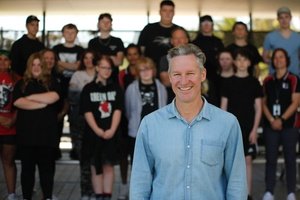According to former primary teacher Dr Nathaniel Swain, now a senior lecturer in learning sciences at La Trobe University, too many Australian teachers do not draw upon responsive and adaptive whole class teaching as a means of catering to classes with diverse learning needs.
“Perhaps they’re used to teaching to the middle, or teaching in a much more small-group way,” Swain, who founded Think Forward Educators, tells EducationHQ.
“Or teaching in secondary (schools), what’s more common is giving [students] a very small amount of instruction at the front end, and then giving a task where students have to find their way through mainly independently with a bit of help, as the teacher floats around.
“And that model is also quite inefficient.”
The instructional coach is keen to highlight that whole class explicit teaching is the ‘sweet spot’ of differentiation, because it targets a single learning objective with rigorous modelling, practice and feedback.
He warns that both streaming various tasks and splitting students into ability groups can cause a range of problems.
For starters, it risks locking students into certain levels of achievement, he notes.
“Students will constantly surprise you in terms of what they’ve understood and what they’ve connected, even students that you thought, ‘Oh, they’re definitely not capable of that’.
“You actually don’t know, and dynamic things happen in student learning trajectories, and sometimes it’s because they’ve been given access to more challenging content.
“I think if you don’t give that access to whole class teaching, then you’ll never know if they can do it or not,” Swain says.
This kind of ‘small-scale streaming’ also inevitably widens the learning gap in the classroom, he adds.
“You’re going to actually push each of those groups further apart, rather than bringing them back together.”
Bear in mind, Swain says, every child doesn’t have to arrive at the same finish line at the end of each lesson.
This is where additional supports and interventions come in to close the gap, as per the Multi-tiered Systems of Support model, he suggests.

Many education academics have pitted differentiated instruction against whole class teaching, Swain laments.
‘Hyper-individualised’ teaching to small groups also establishes a classroom pecking order, where some students are seen to be ‘better’ and learning more than others,” Swain adds.
“It does mean that students will be aware of ‘that group does the easy stuff’ because they’re in the low group.
“And that’s not a great precedent to set when, actually, there’s a lot more benefit to having a communal and a collective approach to teaching and learning in your own classroom, where we’re all learning together.
“Even if each of us are getting different things out of the one experience, we’re still having that one shared experience, which I think is important,” Swain reflects.
And whenever teachers opt for differentiated small group work, students ultimately receive less learning time that’s guided by an expert, Swain argues.
“Even if you have only four groups, it means that you basically teach your students a quarter of the time that you would [otherwise],” he says.
The question here is, what are the students you’re not teaching occupied with?
“If you’re [having] 30, or 40, or 90 minutes a day of small group instruction, then students are essentially only able to spend a quarter or a fifth of the time with you as the teacher.
“The rest of the time, you have to keep them busy with other activities – there’s questionable value of what [these are].”
Swain believes this scene is all to common in classrooms across the country, and especially in primary schools.
“If they’re learning things that they can’t already do, they actually need the expert – which is the teacher – with them with at the time,” he says.
Many education academics have pitted differentiated instruction against whole class teaching, Swain laments, which he argues is often characterised as an outdated and limiting one-size-fits-all approach.
“I think these claims are based on pretty traditional notions of what whole class teaching can look like, and they often don’t have a lot of empirical evidence behind them,” he contends.
Very few studies have compared the effectiveness of two teaching conditions side by side, he adds.
“So, some people might assume that because we don’t have a lot of empirical evidence showing that whole class works better than small group (instruction) or vice versa, it just doesn’t make logical sense for whole class to work because it is philosophically seen as a one-size-fits-all approach.”
The expert is keen to emphasise that it’s entirely possible to be a brilliant responsive, adaptive and differentiated teacher, without having to split your instruction into many different parts.
And while a substantial research base shows explicit teaching is the most effective instructional approach for getting novice learners to master new content and skills, whole class teaching is something of a black hole in academia, he suggests.
“In terms of how teachers make real time decisions to improve their instruction and to adapt and respond to learning in real time, I think there actually needs to be more research in this space, and also more awareness in the general teaching profession…”
Swain has braced himself for backlash over his views.
“The idea of putting this out there is to counter the view [of] people (that) see the work of schools that are trying to implement things in a more explicit way, or a way that aligns with the science of learning, as not inclusive, because it doesn’t cater for different learning needs, or whatever it might be.
“So, I’m expecting there’s some people who are out there who are thinking that small group instruction is really essential – and that’s a pretty commonly held idea…”
Swain encourages those aligned with this school of thought to go out and see fast-paced and engaging whole class instruction in action.
“Whole class instruction is probably not what you think it is, or in the instruction you’ve seen before in your own schooling,” he says.
Dr Nathaniel Swain posts regularly about the science of learning on his blog Cognitorium.














